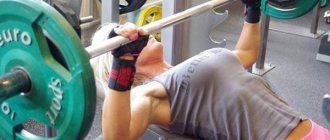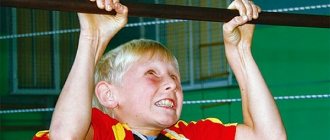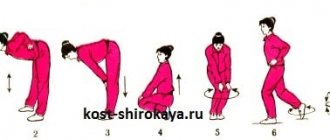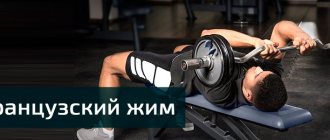Surovetsky Askold Evgenievich Press system No. 1
Warm-up: 30x8, 45x6, 60x6, 70x5, 80x4, 84x3, 88x3
| put the squeeze on | |||||||||||
| No. tren | 92% | 96% | 100% | 92% | 90% | 88% | 86% | 84% | 82% | 80% | 100% |
| 1 | 2x4 | 2x2 | |||||||||
| 2 | 2 | 2 | 2x5 | 2x2 | 3x2 | ||||||
| 3 | 3 | 2x6 | 2x3 | ||||||||
| 4 | 2 | 1 | 1 | 2x3 | 2x3 | 3x3 | |||||
| 5 | 3 | 2x4 | 3x3 | ||||||||
| 6 | 2 | 2 | 2x5 | 3x3 | |||||||
| 7 | 2 | 2 | 1 | 2x3 | 2x2 | 3x4 | |||||
| 8 | 3 | 2 | 2x4 | 2x3 | |||||||
| 9 | 3 | 2 | 1 | 2x3 | 3x3 | ||||||
| 10 | 3 | 2 | 1 | 2x3 | 2x2 | 3x5 | |||||
11 - 30%x10; 45%x8; 60%x6; 70%x3x5 12 - 36%x8; 54%x6; 68%x5; 76%x4% 84%x3; 92%x2; 100%x1, penetration
An auxiliary exercise that is not similar to a movement is used more and more to strengthen ligaments, pump up, and in the strength cycle, almost half of it is done using auxiliary movements similar to the main one. Never do it to failure in the back room: do it for your own pleasure, not all the way, but with a reserve of 2-3 repetitions. Usually: on blocks up to 8 repetitions, with dumbbells and barbells - up to 6 repetitions. Approaches: one just trial and 3-4 main ones.
The only thing you can do after the bench press is: sitting (lying) flyes – 4 x 6, forward arm raises – 4 x 6, back, rear deltoid, biceps. Triceps can be done on the same day, followed by two days of rest: usually parallel bars and triceps pulleys. There is one movement that almost no one does, but in vain. These are push-ups. Hands should be positioned at grip width when pressing. The support of the legs should be higher than shoulder level. You can add weight to your back. And do push-ups (you get half-presses) 3-4 sets of 6 to 10 repetitions.
The last weight in training is performed with a pause on the chest for 2-3 seconds. The first approaches in workouts 1 to 10 are the same. The push-up is performed from a stand on the chest with a height of approximately 10-12 cm. The first number is approaches, the second is repetitions.
After completing system No. 1, move on to system No. 2.
Press system no. 2
| No. tren | 36% | 54% | 68% | 76% | 80% | 84% | 88% | 92% | 88% |
| 1 | 8 | 6 | 6 | 5 | 4 | 3 | 3 | 2x2 | 2x3 |
| 2 | 8 | 6 | 6 | 5 | 4 | 3 | 4x3 | ||
| 3 | 8 | 6 | 6 | 5 | 4 | 5x5 | |||
| 4 | 8 | 6 | 6 | 5 | 4 | 3 | 3 | 3x3 | 3x3 |
| 5 | 8 | 6 | 6 | 5 | 4 | 3 | 3x3 | ||
| 6 | 8 | 6 | 5 | 4 | 3 | 3 | penetration |
Questions: Is it possible to do presses in a T-shirt instead of push-ups with the same weight and number of repetitions?
If you work in a T-shirt, then it is better to work in it instead of push-ups.
presses in a T-shirt, increase the weight of the projectile? What maximum should you push off from - equipped or without?
Of course, push up in a T-shirt from the maximum in a T-shirt and take more than the maximum
When bench pressing in a T-shirt, what number of repetitions and approaches should I stick to?
Everything is the same according to the system, only on days with heavy weights, perform in a T-shirt after 80%
Do the bench press in a T-shirt work at full amplitude or just push-ups?
Strive for full amplitude, maintaining the desired trajectory of the barbell. But on the first approaches, the weight will be too small to lower completely onto the chest.
What schemes for squatting and deadlifting can be combined with bench press No. 1?
I don’t associate pressing systems with squats and deadlifts at all. I use any system. I believe that only the squat and deadlift are interconnected.
Sorry, maybe I don’t understand something, I have no experience working with systems of this kind... The weights according to the diagram are located like this: 92, 96, 100, 92%, etc. That is, first to increase, then to decrease... In that order and do it?
Yes, sure.
To what level should we push? Since the weight is considerable and the load is not bad, this is important.
In boosters, the descent goes to the possible level. But you shouldn’t lower more than half the distance; it’s better to add weight.
Is it reasonable to only do Zhno.2, without Zh.No.1?
You can repeat one system. This is not fundamentally important. I used to do this for Zh No. 2. Until you feel physically and psychologically saturated. Then you switch to another system, interest and desire appear again.
The question arose: why is there no support for the anterior deltoids and triceps in the Zh1 system, but there is one in the Record system? Although I do bench press here and there 3 times a week.
Because in W#1 all workouts put a lot of stress on the deltoids and triceps, and in “Record” heavy workouts alternate with light ones.
After push-ups my shoulders hurt. Can he do a hold or a negative instead of push-ups?
No need for negativity. Deductions are possible. Or give up boosters altogether. Instead, something for the triceps.
Is it possible to do overhead presses or dumbbell lateral raises using the 1/2 press system?
All other barbell hand presses are unnecessary. You can do lateral raises on the middle delta if you need it.
Please tell me, is it possible to replace the 11th workout with a speed press in bench press No. 1? If the preparation goes without surprises, I will have the 11th training session on Wednesday, and the competition on Sunday.
Under no circumstances, especially before competitions.
Is this program suitable for beginners?
This program is suitable for everyone, everything comes from real maximums. 80 or 180, what difference does it make if this is the current maximum. And the percentage regulates the load for both.
Is it possible to do it without heavy pharmaceutical support or does the program imply it, like Muravyov’s?
Perhaps, just take the real maximum, and not the planned one.
What is the average increase from your cycle? I understand that organisms are different and much depends on experience. But there must be an average figure.
I never promise anyone any increase. I even think it's stupid. Imagine: I make a promise to someone - and during the course of classes, he either has no food, or the regime is bad, then he missed the lesson, then he rescheduled, then he got sick, then he was overworked, then he was injured, ... yes, there may be a thousand reasons that are not even mentioned you suspect. And that’s it, it didn’t work out as promised! The coach is to blame. Nothing can be promised! This is what you will come to the end of the program with, this is what you actually earned during this period: it can be better or worse. And every written program, I always say, is a book version. In practice, with a coach, it always undergoes correction, since the coach sees what the athlete is doing and how, where something needs to be added or subtracted, etc. You must adhere to the program, but do not assume that it in itself will give you a big increase. Basically, it all depends on you! And ideally, any program, I say ANY program, brings some positive result if there is the diligence of the person himself, his truly serious approach to his studies. Well, more from practice. Beginners gain easily and a lot (in percentage terms), while high-class athletes gain heavily and a little. This is understandable: beginners still have great potential, but masters are already at their limit.
Is it possible to combine your N1 and N2 bench press program with a squat? Or is it better to take a 16-week program then? I also wanted to ask about the accessory to the bench press program: that it does not require any assistance at all, not even lifts or rows of the barbell to the belt?
Press No. 1 and No. 2 are included in the same basic program. It's indicated there. In these pressing programs, I do not recommend doing assistance only on the anterior deltoid and triceps. You can do everything else. You probably understand that bent over rows (to the waist, as you called them) are for the lats. And the wiring is different. It is better not to do dumbbell flyes while lying down.
There are a lot of bench press sets here (up to 18), and most with weights close to the maximum. The question is: what level of training was the system originally designed for? On whom? And what emphasis is pursued in this system (technique, pure strength, or something else)? Should recovery levels be ideal on a three-times-a-week cycle? I’ve been coping with the training myself for now, using the three-times-a-day regimen for three weeks now. But my sleep worsened, I became restless...
My answer is probably not entirely scientific, but as long as it is clear.
- I always maintain that percentage systems are suitable for any level of training. It all depends on the performer. Not everyone can withstand intense exercise, not everyone has a sufficient degree of body recovery, and so on. There are many factors, but these are other issues and, by the way, regulated. The system is not a dogma, it allows you to reduce or add something (I couldn’t write about everything there), that is, to bring it to suit your capabilities.
- This system was designed to target all major areas of range of motion in every workout. Objective: intense impact on the body (central nervous system, muscles, ligaments) in order to overcome obstacles to the manifestation of strength.
- The rate of recovery every other day may not be ideal. Therefore, as in other sports, the loads seem to be superimposed on the previous ones. But this also creates a higher level of preparedness of the body. And in the future it has a positive effect on the result if the actions were prudent.
- If you experience such increased excitability, then you need to take certain measures. Vitamins, minerals, etc.... But consult with knowledgeable people. Honey helps very well. And besides, all this may not happen because of training.
ZhNo.2 is much smaller in scope of work than Zh.No.1, in connection with which the question is: On carrying out Zh.No.2 after Zh.No.1. Is this intended for recovery after severe exercise? Is it reasonable to only do Zhno.2, without Zh.No.1? Or is the whole meaning in a complex, one after another?
You can repeat one system. This is not fundamentally important. I used to do this for Zh No. 2. Until you feel physically and psychologically saturated. Then you switch to another system, interest and desire appear again.
1. Press No. 2 - a total of 6 workouts - two weeks, so every 2 weeks you get to the maximum? 2. Press No. 2 - how will the pre-competition scheme go? 3. Are boosters needed? (in general, it’s voluminous, but it seems like the system is lighter than No. 1)
1. Yes. Does this bother you? What I'm saying is that you can change systems. 2. As pre-competition it is better than W#1. 3. In W#2 there is no need to do push-ups.
I completed your program Zh No. 1. After what break can you repeat program No. 1? Or is it better to do Zh No. 2?
No breaks needed. Try to do Zh No. 2, and then again Zh. No. 1.
Is it possible in the system of press No. 1, instead of push-ups, to do a full press with a narrow grip with a large weight (88-90%) for the same number of “sets*repetitions” as push-ups?
Can.
You wrote that the first approaches in workouts 1 to 10 are the same. Question about the 1st workout: do the 6th (84%) and 7th (88%) preparatory approaches, or immediately after the 5th preparation (80%) do 2x4 - 84% of the main ones?
The first seven approaches are highlighted separately. They are performed in all workouts from 1 to 10. And after them, further along the table. Same thing in the first training session.
How long to rest between sets?
The rest time is determined by readiness for the approach. Approximately from 1 to 6-10 minutes. Naturally, on the first approaches it will be less, since the weight is lighter.
I have a question, is it possible to list the trainings by numbers, which are considered light, medium and heavy (apparently you don’t have enough brain on your own).
Conventionally: 1 - light, 2 - heavy, 3 - medium. 4 - heavy, 5 - light, 6 - medium. 7 - heavy, 8 - light, 9 - medium. 10 - heavy, 11 - very light, for restoration, 12 - penetration.
Are the workouts tied to the days of the week in terms of 1st - Mon, 2nd - Wed, 3rd - Fri, etc. (well, either Tue, Thu, Sat, respectively), or is it absolutely unimportant, and you can start the first workout both on Monday and on Wednesday and Friday?
Of course not. What do the days of the week have to do with it? It is important to maintain your training regimen.
Over the course of a year, I ran the system five times. Each time there was an increase of 5-7 kg. The training was every other day, but this was enough for me to recover. But! With the increase in weight, I feel under-recovery. there is a desire to rest for a day or do a light workout. What do you recommend?
Do not enter any other (light) training into the system. There are options:
- Go to training with two days of rest.
- Conduct training to feel ready. That is, they can be either in a day or in two. But never rest for more than two days - it’s bad for maintaining fitness and for the ligaments. And the ligaments need to be kneaded and stretched on rest days.
If, when completing the program Zh No. 1, you feel that the maximum from which you calculated the percentage has increased, you can recalculate the percentages and continue training to achieve even greater results.
They have written repeatedly that there is no need to count anything! End the system with the old design maximum. And there is no need to rush to injuries, they will catch up with you anyway. 
Is it possible to do push-ups in a T-shirt?
Can.
I adhere to the point of view that you need to start training in a T-shirt a month or a little more before the competition, since it has been tested that if you always bench press in a T-shirt, certain muscle groups begin to lag behind :) and about the fact that you need to press constantly in a T-shirt and like if not then she won’t give you a press - I don’t think it’s true:) I bought a T-shirt before I pressed 5 times I put on the T-shirt and in the first training I gained 30 kilograms:) something I left -... and here’s the question: is there any training system for these 1.5 months, or do you need to continue that system by recalculating the maximum from the bench press in a T-shirt?
The approach to the T-shirt is individual. You got good at it right away. This means there is no point in doing training in it often. A month and a half before the competition, turn on the T-shirt during training with heavy weights (in the W#1 system these are 2,4,7,10th). Some very good benchers wear the shirt 2-3 times and say that's enough for them. The main thing is the ability to feel the shirt, it doesn’t increase strength, but it’s a pity for your elbows. So if you are going along W#1, then continue, but you don’t need to count from bench presses in a T-shirt. You will use it in the above workouts like this: first you do the press according to the system up to 92%, then you put on the T-shirt. In a T-shirt, first you perform incomplete presses (but lower and lower) for 2 repetitions with weights (as a percentage of the maximum without a T-shirt): 100/2, 106/2, 112/2. Then you try to do a full bench press for 1 repetition with weights: 118-124/3x1. And you can also add push-ups in a T-shirt: 130-142/3x2 (any amplitude of movement, even the smallest, but keep the weight and do it). That's all. Understand correctly: the calculation is the same - from the shirtless maximum (92%). And then all the percentages are from this maximum, but are performed in a T-shirt (100%, 106%, etc.).
Hello! Tomorrow I have a planned walk (about +7.5), but I’m sick, what should I do now? ((I’m thinking of loading up on vitamins today, going for a walk, and then doing only the first workout until I recover.
Where to go? Only to the pharmacy. You need to get treatment. Forget about the passage. Then it’s better to repeat everything again.
Are boosters made with a 2 liter bottle and a bridge?
That made me laugh. Nowhere without a bottle. We perform the press in the same position as a regular bench press, and without any supports on the chest.
I’m interested in your opinion...why without a stand...do we do boosters?
I'm not against either performance. But lately I’ve been leaning more towards chest presses without supports. I think the main reasons are:
- more accurate and precise execution of the movement (and therefore less risk of injury),
- the presence of “negative” in this amplitude section (this is a plus),
- developing the ability to control movement with weights greater than the maximum (well, and getting used to holding them),
- self-control of the level of lowering (self-insurance - again against the risk of injury).
Probably missed something else.
To what level should we push?
In push-ups, the lowering goes to the possible level. But you shouldn’t lower more than half the distance; it’s better to add weight.
If during the boost, when adding weight, you can only lower it by a third? Shouldn't we reduce it back?
It's quite normal. After all, it is recommended to even just hold the weight.
Deadlift - Honored Powerlifting Trainer of the Russian Federation Askold Surovetsky
The final chord in powerlifting competitions is three approaches to the deadlift exercise. The final result in the triathlon total depends on them. Therefore, this chord should sound very impressive. I consider this movement to be the main one in eventing, it decides whether you will be with a shield or on a shield. This means that it must be executed in such a way that there is no doubt whether it will work or not? And there must be complete confidence that if it comes to deadlifting, now there is only success. Let's rephrase: those who don't have good deadlifts don't drink champagne.
I would like to share my thoughts on movement technique, as well as the practice of developing strength in the “deadlift” exercise. I probably won’t reveal anything special for experienced coaches and athletes. The deadlift is a technically simple movement at first glance, and to increase results it is not necessary to invent any special approach schemes. If you look at the deadlift training systems of famous strength athletes (for example, Dan Austin, Ed Cohen, John Cook) or the “Finnish” system, you will see that they are all built on simply increasing the weight lifted in approaches from workout to workout.
In fact, the deadlift movement consists of many seemingly insignificant details that affect the quality of the movement, and therefore the result. And perhaps some of my comments in the detailed description of the technical execution of the deadlift will help in practice those who are interested in serious work on the deadlift.
The deadlift, in its physical and mechanical content, is the only movement during which the largest number of body muscles are involved in the work. Hence, the attitude towards it often resembles the position that, they say, it is not so important to improve the technique and you can lift a lot with your “naked” back. But this is the same as performing the movement without using a special form. For this purpose, the most rational and effective technique in each movement is determined in order to direct the “naked” force in the right direction to significantly increase the result.
There are two ways to perform deadlifts: classic and sumo style. It must be said right away that the “sumo” style is more advantageous for using all the strength an athlete has. Despite the fact that the body structure of people differs, practice shows that in any case, with good development of the movement technique, the effectiveness of the “sumo” style is undoubtedly higher. What is the technique for optimally performing sumo-style deadlifts?
Starting position: spread your legs as wide as possible under the barbell. Turn your socks at an angle of 45-60 degrees. Place your feet halfway under the barbell. The back is straight.
Preparatory phase: from the starting position, keeping your back straight, lower yourself by squatting, bending your legs and moving your knees in the direction of your toes. Tilt your head slightly to see the barbell. Move the pelvis forward closer to the bar, remove the deflection in the lower back. Reach down with your arms only by lowering your shoulders by turning them forward and down, and keep your back rigidly straight. When lowering, the leg muscles should stretch, as if the string of a bow, and prepare for the reverse movement. You need to sit down just enough to be able to grab the barbell.
Starting position: knees are turned out as far as possible and directed towards the toes. The pelvis is close to the bar. The back is straight and tense. The shoulders are lowered and vertically above the barbell. Keep your head straight. Grip the bar only with a different grip. The fingers should not squeeze the barbell; they should be used as hooks. The hands in the deadlift act only as a connecting link between the points of application of force.
Initial phase: after a good inhalation, tighten the entire body with gradually increasing effort. Keep your pelvis closer to the bar. It is very important to withstand the initial load without distorting the starting position. The whole body must prepare to lift the barbell. It must be borne in mind that the shoulders and upper back are slower to engage in movement. Therefore, holding at the bottom is required until the bar lifts off the platform.
We must strive to ensure that the entire load in this phase is transferred to the support, that is, to the feet. You have to feel the pressure there. Do not make sudden movements under any circumstances. This is not a jerk, this is a pull. Everyone knows that the results in the snatch are much lower than in the deadlift. So why immediately put yourself at a disadvantage? After all, the goal of the deadlift is not to lift the barbell off the platform, but to lift it into a straightened body position.
Main phase: after lifting the barbell off the platform, all the muscles of the body are ready to work at full strength; now, while holding your breath, active straightening of the legs begins while rigidly maintaining the position of the body. It is necessary to ensure that the shoulders do not lag behind the upward movement of the pelvis. The barbell should move as close to your legs as possible. The head is straight or slightly tilted back.
End phase: Legs are fully straightened. The body begins to be carefully brought to a vertical position and the shoulders turn. The pelvis and chest move forward. At the same time, a tense “power” exhalation is done. The shoulders remain lowered and only after straightening the body turn back.
And a few more notes about the peculiarities of performing sumo-style deadlifts:
1) In the starting position, too much rotation of the feet leads to poor stability in the final phase and requires more precise execution of the entire movement. If you reduce the distance between the feet, the distance when lifting the bar will increase. If the barbell is closer to the toes, then in the initial phase the leverage between the support and the center of gravity will increase. As a result, the load on the back will increase and it will become much more difficult to lift the barbell off the platform and subsequently straighten the body.
2) In the preparatory phase, simple, unassembled lowering of the bar entails serious negative consequences. Firstly, from below it is more difficult to take the correct starting position and prepare all the muscles for a good start to the movement. Secondly, the lowering of the pelvis in this case occurs lower than necessary and, as a result, the path for lifting increases. The preparatory phase is a very important part of the movement that is often overlooked in training.
3) In the starting position, poor knee alignment removes the pelvis from the barbell, increases the load on the lower back and creates difficulty in lifting the barbell off the platform. A bent back leads to problems in the final phase of straightening. If you do not lower your shoulders to the limit, you will have to squat lower, which will increase the distance you lift the barbell.
4) In the initial phase, lifting the pelvis before the shoulders leads to a tilt of the body, which means the same consequences: an increase in the load on the lower back, making it more difficult to lift the bar and straightening the body in the final phase.
5) In the main phase, if, during active straightening of the legs, the movement of the shoulder body lags behind the lifting of the pelvis in speed, then the back bends with the corresponding consequences. Removing the barbell from your legs can also lead to this.
6) In the final phase, a bent back can become an obstacle to completing the movement. A common mistake at the end of the movement is lifting the shoulders before moving them back. This leads to reverse movement of the bar, which is prohibited by the rules.
Training systems for deadlift athletes can be different. They even need to be changed periodically. The main thing is that they adhere to the principle of constant progression of training weights in approaches. Systems should last 8-12 weeks and end with a test for maximum results (approximately 104 - 108%).
I invite you, dear readers, to familiarize yourself with one of my systems, which I use as a base one. The basis for calculating training weights is the maximum result shown immediately before applying this system.
Beforehand, at each workout, a general preparatory warm-up for deadlifts is performed, mainly leg stretches, hyperextensions and bends without weight, squats and body transfers from foot to foot in a wide stance. Then perform 4-5 warm-up sets of deadlifts, starting with about 30% weight and gradually increasing it to the main sets, while simultaneously reducing the number of repetitions from 6 to 3.
For example, if your maximum deadlift result is 200 kg, then the warm-up looks like this:
a) for odd workouts: 60x6, 85x5, 110x4, 135x3; b) for even training: 60x6, 90x5, 120x4, 150x3.
Main part: 1 workout. 70% 5 reps in 5 sets; 2. 81% 3x1, 85% 2x1, 88.5% 1x3; 3. 72.5% 5x5; 4. 81% 3x1, 85% 2x1, 88.5% 2x3; 5. 75% 5x5; 6. 82.5% 3x1, 87.5% 2x1, 94% 1x3; 7. 77.5% 4x4; 8. 82.5% 3x1, 87.5% 2x1, 94% 2x3; 9. 80% 4x4; 10. 84% 3x1, 94% 2x1, 100% 1x3; 11. 82.5% 4x4; 12. 84% 3x1, 94% 2x1, 100% 2x3; 13. 85% 3x3; 14. 85.5% 3x1, 97.5% 2x1, 105% 1x3; 15. 87.5% 3x3; 16. 85.5% 3x1, 97.5% 2x1, 105% 2x3; 17. 90% 2x2; 18. penetration to maximum.
The break between workouts should be at least 3-5 days. It would be better if you take a break of 5 days between odd and even training, and 3 days between even and odd.
As additional exercises, the following are mainly used: rows of the upper block with a wide grip behind the head and to the chest, rows of the lower block sitting to the stomach with a narrow grip, hyperextension. They are performed in 3-4 sets of 8-10 repetitions. I can also use other exercises (pull-ups on the bar, bent-over barbell rows with a narrow and wide grip, etc.). But it is not recommended to do more than 3 additional exercises in one workout.
When during preparation weak points in the execution of a movement are identified, it is necessary to include special exercises in the training, for example, to increase the force required when lifting the barbell off the platform, rowing from a lower position is used, standing on stands approximately 10 cm high in the same position legs - with a wide stance. It is usually performed immediately after the main deadlift in 4-5 sets of 5-6 repetitions with increasing weight from approach to approach.
It is often difficult to straighten the body when completing a deadlift. This is due to the fact that the back muscles are not held rigidly and it bends too much in the middle part. To enhance muscle work in this area of the movement, pulling the barbell from stands, also in “sumo” style, helps well. The height of the stands should be such that the barbell is just below the knees. The weight is set 10-30 kg more than the maximum and 3-5 sets of 1-3 repetitions are performed. The stretch is performed on even days of training.
To consolidate the execution technique, it is advisable to perform deadlifts in each approach on odd days without stopping, that is, do not place the barbell on the platform, but only touch it and immediately do the next repetition. Also, in all approaches, lowering from the top position with the barbell is performed not by bending the back, but by sitting down, trying to maintain the body position as it should be when lifting the barbell. It must be said that great patience is required in the process of practicing lifting the barbell off the platform. Maximum rotation of the knees creates great tension and pain in the hip joints and in the ligaments of the adductor muscles of the thigh. This painful process takes a long time, but it must be completed without interrupting training.
And one more note. If you don’t want to have problems holding the barbell in your hands, then never use wrist straps in your approaches. If your arms don’t hold, then no back will help you take more weight. And training without straps only develops your grip. And this requires practically no additional exercises; they can even interfere, since overloading the forearms weakens the grip. And when reaching from stands, you will hold more weight than the maximum. So don’t put unnecessary strain on your back and forearm, save your strength for the main movement. And lastly, the rest between approaches should be: 1-3 minutes in the warm-up part of the system, and 5-10 minutes in the main part. There is no need to rush, but there is also no need to delay it too much.
I tried to explain in more detail the deadlift technique and training system. But many questions will still arise. In practice, it can be difficult to achieve a complete combination of all elements without the special attention of the coach, understanding and effort of the athlete. All that remains is to wish you success in achieving better results, in which, perhaps, my experience will help.
Author: Honored coach of the Russian Federation in powerlifting Askold Surovetsky
Rate this article:
[Total: 0 Average: 0]
Similar
Surowiecki bench press cycle
Surovetsky Askold Evgenievich
Press System No. 1
Warm-up: 30x8, 45x6, 60x6, 70x5, 80x4, 84x3, 88x3
| put the squeeze on | |||||||||||
| No. tren | 92% | 96% | 100% | 92% | 90% | 88% | 86% | 84% | 82% | 80% | 100% |
| 1 | 2x4 | 2x2 | |||||||||
| 2 | 2 | 2 | 2x5 | 2x2 | 3x2 | ||||||
| 3 | 3 | 2x6 | 2x3 | ||||||||
| 4 | 2 | 1 | 1 | 2x3 | 2x3 | 3x3 | |||||
| 5 | 3 | 2x4 | 3x3 | ||||||||
| 6 | 2 | 2 | 2x5 | 3x3 | |||||||
| 7 | 2 | 2 | 1 | 2x3 | 2x2 | 3x4 | |||||
| 8 | 3 | 2 | 2x4 | 2x3 | |||||||
| 9 | 3 | 2 | 1 | 2x3 | 3x3 | ||||||
| 10 | 3 | 2 | 1 | 2x3 | 2x2 | 3x5 | |||||
11 – 30%x10; 45%x8; 60%x6; 70%x3x5 12 – 36%x8; 54%x6; 68%x5; 76%x4% 84%x3; 92%x2; 100%x1, penetration
An auxiliary exercise that is not similar to a movement is used more and more to strengthen ligaments, pump up, and in the strength cycle, almost half of it is done using auxiliary movements similar to the main one. Never do it to failure in the back room: do it for your own pleasure, not all the way, but with a reserve of 2-3 repetitions. Usually: on blocks up to 8 repetitions, with dumbbells and barbells - up to 6 repetitions. Approaches: one just trial and 3-4 main ones.
The only thing you can do after the bench press is: sitting (lying) flyes – 4 x 6, forward arm raises – 4 x 6, back, rear deltoid, biceps. Triceps can be done on the same day, followed by two days of rest: usually parallel bars and triceps pulleys. There is one movement that almost no one does, but in vain. These are push-ups. Hands should be positioned at grip width when pressing. The support of the legs should be higher than shoulder level. You can add weight to your back. And do push-ups (you get half-presses) 3-4 sets of 6 to 10 repetitions.
The last weight in training is performed with a pause on the chest for 2-3 seconds. The first approaches in workouts 1 to 10 are the same. The push-up is performed from a stand on the chest with a height of approximately 10-12 cm. The first number is approaches, the second is repetitions.
After completing system No. 1, move on to system No. 2.
Press system no. 2
| No. tren | 36% | 54% | 68% | 76% | 80% | 84% | 88% | 92% | 88% |
| 1 | 8 | 6 | 6 | 5 | 4 | 3 | 3 | 2x2 | 2x3 |
| 2 | 8 | 6 | 6 | 5 | 4 | 3 | 4x3 | ||
| 3 | 8 | 6 | 6 | 5 | 4 | 5x5 | |||
| 4 | 8 | 6 | 6 | 5 | 4 | 3 | 3 | 3x3 | 3x3 |
| 5 | 8 | 6 | 6 | 5 | 4 | 3 | 3x3 | ||
| 6 | 8 | 6 | 5 | 4 | 3 | 3 | penetration |
Questions: Is it possible to do presses in a T-shirt instead of push-ups with the same weight and number of repetitions?
If you work in a T-shirt, then it is better to work in it instead of push-ups.
presses in a T-shirt, increase the weight of the projectile? What maximum should you push off from - equipped or without?
Of course, push up in a T-shirt from the maximum in a T-shirt and take more than the maximum
When bench pressing in a T-shirt, what number of repetitions and approaches should I stick to?
Everything is the same according to the system, only on days with heavy weights, perform in a T-shirt after 80%
Do the bench press in a T-shirt work at full amplitude or just push-ups?
Strive for full amplitude, maintaining the desired trajectory of the barbell. But on the first approaches, the weight will be too small to lower completely onto the chest.
What schemes for squatting and deadlifting can be combined with bench press No. 1?
I don’t associate pressing systems with squats and deadlifts at all. I use any system. I believe that only the squat and deadlift are interconnected.
Sorry, maybe I don’t understand something, I have no experience working with systems of this kind... The weights according to the diagram are located like this: 92, 96, 100, 92%, etc. That is, first to increase, then to decrease... In that order and do it?
Yes, sure.
To what level should we push? Since the weight is considerable and the load is not bad, this is important.
In boosters, the descent goes to the possible level. But you shouldn’t lower more than half the distance; it’s better to add weight.
Is it reasonable to only do Zhno.2, without Zh.No.1?
You can repeat one system. This is not fundamentally important. I used to do this for Zh No. 2. Until you feel physically and psychologically saturated. Then you switch to another system, interest and desire appear again.
The question arose: why is there no support for the anterior deltoids and triceps in the Zh1 system, but there is one in the Record system? Although I do bench press here and there 3 times a week.
Because in W#1 all workouts put a lot of stress on the deltoids and triceps, and in “Record” heavy workouts alternate with light ones.
After push-ups my shoulders hurt. Can he do a hold or a negative instead of push-ups?
No need for negativity. Deductions are possible. Or give up boosters altogether. Instead, something for the triceps.
Is it possible to do overhead presses or dumbbell lateral raises using the 1/2 press system?
All other barbell hand presses are unnecessary. You can do lateral raises on the middle delta if you need it.
Please tell me, is it possible to replace the 11th workout with a speed press in bench press No. 1? If the preparation goes without surprises, I will have the 11th training session on Wednesday, and the competition on Sunday.
Under no circumstances, especially before competitions.
Is this program suitable for beginners?
This program is suitable for everyone, everything comes from real maximums. 80 or 180, what difference does it make if this is the current maximum. And the percentage regulates the load for both.
Is it possible to do it without heavy pharmaceutical support or does the program imply it, like Muravyov’s?
Perhaps, just take the real maximum, and not the planned one.
What is the average increase from your cycle? I understand that organisms are different and much depends on experience. But there must be an average figure.
I never promise anyone any increase. I even think it's stupid. Imagine: I make a promise to someone - and during the course of classes, he either has no food, or the regime is bad, then he missed the lesson, then he rescheduled, then he got sick, then he was overworked, then he was injured, ... yes, there may be a thousand reasons that are not even mentioned you suspect. And that’s it, it didn’t work out as promised! The coach is to blame. Nothing can be promised! This is what you will come to the end of the program with, this is what you actually earned during this period: it can be better or worse. And every written program, I always say, is a book version. In practice, with a coach, it always undergoes correction, since the coach sees what the athlete is doing and how, where something needs to be added or subtracted, etc. You must adhere to the program, but do not assume that it in itself will give you a big increase. Basically, it all depends on you! And ideally, any program, I say ANY program, brings some positive result if there is the diligence of the person himself, his truly serious approach to his studies. Well, more from practice. Beginners gain easily and a lot (in percentage terms), while high-class athletes gain heavily and a little. This is understandable: beginners still have great potential, but masters are already at their limit.










